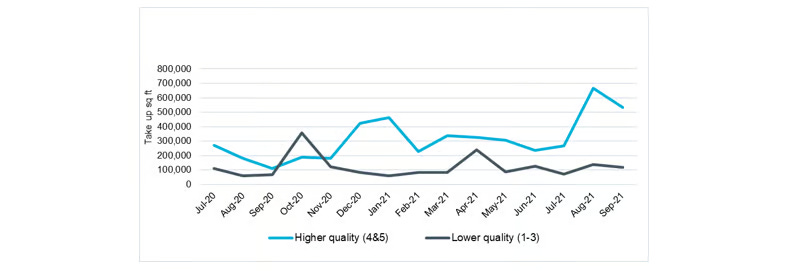Strategies for Developing Low-Carbon Real Estate Today: A Future-Ready Approach
The New Gold Standard: Developing Real Estate with Sustainability at its Core
ESG in Real Estate will keep being high on the agenda for some time. Occupiers and ESG-driven investors are seeking assets with high sustainability credentials, in short, high-quality assets are in strong demand whilst lower-grade buildings with poor sustainability ratings are at risk of being left stranded.
So what can Real Estate Developers do to help transform assets from brown to green to make them attractive to investors?
The market is evolving fast and right now several possible solutions can be adopted in the development or refurbishment of buildings to aim for a low carbon footprint.
Now, let’s dive in.
Innovative Low-Carbon Structural Materials: The Future of Construction
A building’s structural frame accounts for about a third of the construction costs and in office buildings for up to 50% of its embodied carbon.
In a typical new office building the structure represents over 50% of the initial embodied carbon.
This means that every new build development must consider a matrix of the structural options available, to establish which ones are feasible within the budget and carbon allowance of the project.
Research in low-carbon structural materials is advancing fast and today it is possible to consider the following low-carbon options:
Mass Timber = > It helps carbon sequestration, but has structural limitations the taller the structure is.
Green Steel = > A huge plant is being built in Sweden to produce low-carbon steel. Costs are likely to be still higher than traditional steel.
Low Carbon Concrete = > Huge advancements are being made in this sector, the latest player Brimstone claims to have found a zero-carbon recipe.
Climate Breakthrough: Brimstone’s Decarbonized Portland Cement First to Meet Essential Building Industry Standard, Unlocking the Potential of Net-Zero Construction
BusinessWire
Raw material cost inflation has started to relax significantly from its post-COVID peak, making options like Mass Timber potentially more feasible. However, these values could change very rapidly due to the current uncertainty on the Geopolitical level.
Powering Green Buildings: Renewable Energy and Efficiency Innovations
Together with embodied carbon, operational carbon is another big factor contributing to a building’s carbon footprint. It’s therefore critical to aim for buildings that are powered by renewable sources and that the plant running them is as efficient as possible.
A very recent news story dated the 10th of March revealed that a New York Developer (Alloy) has recently completed the first all-electric residential building in New York.
Brooklyn Scores With the First All-Electric Building in New York City
Alloy Development decided to keep gas appliances out of its new building, 505 State Street, for sustainability. The rule that would have required that move goes into effect in 2026.
The New York Times, March 10, 2024.
This was achieved by banning all gas use from the development.
In addition, Roof-scapes should be exploited for the installation of PV panels and Solar Thermal panels for hot water. Unfortunately in dense city centre urban grids, these systems are often not feasible or efficient due to overshadowing from neighbouring buildings.
An efficient Mechanical plant is also critical and can go a long way to help make energy consumption more efficient.
A few systems that every building should consider including are:
Heat recovery systems.
Batteries to store electrical energy for re-use.
Smart HVAC systems = > See this example by Danfoss.
Urban Ecology: The Impact of Green Roofs and Terraces
Roofs of buildings can do a lot more than just protect from the elements and can have a significant impact on the energy efficiency of the interior.
One of the great benefits of having a green roof is the added insulation performance resulting in improved energy conservation especially in winter thanks to reduced heat loss.
More importantly, adding green roofs helps increase the greening of cities, which helps reduce temperatures in summer and therefore reduces the need for mechanical cooling systems.

Sustainable Practices in Construction
Construction activities are also a key contributor to the carbon footprint of buildings. As such it’s critical to implement practices that reduce the carbon emissions during the construction phase.
To do this requires a coordinated effort by the whole supply chain involved. Here the leadership of Developers and General Contractors is critical to make sure that suppliers establish adequate low-carbon practices.
General Contractors should take a leading role in the following areas of improvement:
Use electric vehicles only.
Review project designs to minimise site delivery trips.
Help implement Design for Manufacturing and Assembly (DfMA) methods of construction.
AI in Energy Efficiency: Transforming Building Performance
In today’s environment, large commercial buildings are under a lot of scrutiny for the energy they consume to simply be kept running. This is regardless of them being fully occupied or empty.
Artificial Intelligence and Machine Learning is becoming a very powerful tool to manage the energy performance within buildings, aiming to create buildings that self-improve to:
Save costs.
Find saving opportunities.
Enhance current systems.
Make systems more adaptable.
Facilitate integration of renewable energy.
To dive deeper into this check out what Brainbox AI is doing to implement this.
Conclusion
Embarking on the journey to low or zero-carbon buildings is ambitious but essential. The industry and its supply chain are making strides in reducing carbon emissions across the board. With continued innovation and commitment, the vision of carbon-negative buildings is within reach.
That's all for today.
See you next week.
Is there anything else that you would like to add to the list?
Subscribe to the Newsletter
A newsletter by Carlo Benigni providing, in less than 4 minutes, exclusive advice, strategies, and resources to help unlock hidden real estate value. Subscribe for free to receive new posts and support my work.








